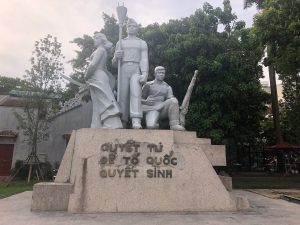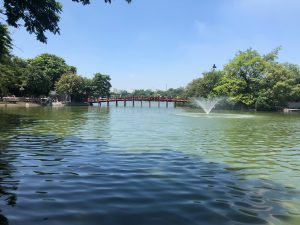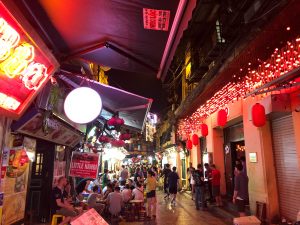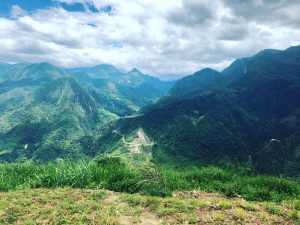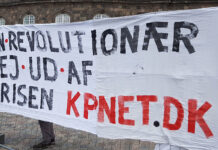The 18th of June 2018 a Boeing 787 aircraft belonging to Vietnam airlines departed from Sydney international airport. I think that most people have a weird feeling during takeoff and landing, because you always think whether it is going to be your last flight or not, even though everybody knows that airplanes are safer than cars and trains. I was not an exception. However, my worst fear did not come true. Takeoff was uncomplicated and I could relax and enjoy my flight. I was excited. Of course I was. This was going to be my second time in Asia. Last year I spent one month in Japan, which was a big cultural shock. Not necessarily in a negative way, but everything was upside down. Now I was on my way to South East Asia, and I was even more excited. How can you not be excited? As soon as I saw the cabin crew, I got a completely different feeling compared to the staff from European airlines. The way they talk, move, look and behave. Everything was different, and mostly in a good way.
However, I had a 10-hour flight waiting for me. I mean, airplanes can be comfortable but you have to keep yourself busy with something if your intentions are not to get bored. So what do I do? Should I read “the grapes of wrath” by John Steinbeck, which was in my hand luggage, or maybe watch a movie? I decided to watch a movie, and guess what I found. “Life is lovely”. A Turkish movie by Müfit Can Sacinci. It is a story about a man, who learns he has a deadly illness, and he begins to do things that he never did. I had a feeling that this was the best way to start my trip to Vietnam. Almost 10 hours later, I arrived in Hanoi international airport.
Before I start my story, I want to answer some few questions people frequently ask me. Why do you travel all the time? Why do you not find a job like everyone else and live a ‘normal’ life? These questions make me smile, but they are also serious questions, and they deserve a serious response. First, I do not travel because I hate working or studying. Second, I do not stay in five star hotels when I travel. Third, most of the time I have a low budget, and if it is possible, I try to live as a local.
I travel because I want to learn. I want to learn more about the world, about myself, our history, and make some of my dreams come true instead of doing the same things all my life. I challenged myself, learned stuff that you cannot learn from a book and learned that you cannot copy people’s life experience. I had to make my own. The Brazilian author Paulo Coelho said: “If you think adventure is dangerous, try routine; it is lethal”. I strongly believe in that, and I do not find it healthy working 8, 9, 10 or 11 hours every single day for a company, which is not even yours. I have seen that everywhere, but especially in Japan. A nation of workaholics who does not question the way, they have organized their society. I find it wrong and unhealthy. Is it surprising that Japan for decades had the highest incidence of suicide? I guess not. I have not been in South Korea, but I have heard that they have similar problems there.
I believe, that people all over the world should have the opportunity to travel, meet strangers, and explore different landscapes and cultures. I find it important that people get the opportunity to challenge their own way of living, instead of being drained by daily routine. Nevertheless, is that possible today in the way we have built our society? No, would be the simple answer. No matter where you live, you have to work and fill someone’s pocket. Even if you are medical doctor, the system will try to make you work like a robot without questioning whether it is good for you or not. I am not saying that people should quit their jobs, and start being a backpacker for the rest of their life. However, I must say, that I do not agree with the common way of thinking. I am aware that there is a huge difference in living conditions between Copenhagen and Mumbai. However, no matter where you live on this planet, people face the same realities. They work for a handful of rich people and companies, and they always have the fear of being unemployed. If you have no income, you will start having serious troubles in your daily life. Especially in countries with lack of social security. I have met hundreds of people during my travels in Cuba, Mexico, Guatemala, Japan, New Zealand, Australia and Europe. Most of them have not been outside their own country. I have been a backpacker for a few years now, and most of the travelers I have met are from Europe, North America and Israel. Even in Europe, it is divided in North and South. Most of the European travelers are from Northern Europe. What does that tell us? Mostly people from wealthy western countries can afford traveling as I did. People living in the poor part of the world are not only poor when it comes to salary, but also in the way of freedom and the opportunity to travel and enjoy life.
Another sad fact is that many of the travelers and backpackers are not interested in finding themselves or learn more about the world. They are interested in party, drugs, sex and are in some way trying to escape from the reality they are living in. I personally do not admire them. I have met some backpackers whom do not only travel for fun. Those people are precious.
I think it is difficult to give a simple answer to these questions, but traveling for me, can in many ways be considered as an eye-opener. A journey where I have learned great lessons in life. I saw beautiful places on earth, and I met beautiful people I did not knew existed. I also witnessed horrible scenes, found out that there are more important things in life than money and material things. I refuse to consume without thinking and questioning. Making meaningful things in life, seeking real friendship and trying to change the world into a better place, has a billion times more value rather than billions on my bank account. That is the reason why the movie “life is lovely” had such an impact on me. We are all going to die. Let us do something good and meaningful instead of repeating the same mistakes. Life does not always give you a second chance, and sometimes it is important to do and say things before it is too late. Here comes the story of “My Vietnam”.
HANOI
At the time aircraft landed, I was exhausted, but the excitement kept me going. At the airport, I met a group of Irish guys, and we shared a taxi to the old quarter in Hanoi. The taxi arrived late that evening, and as soon as I got out of the taxi, I had my second cultural shock in Asia. All I could hear was “hello motorbike”, “marihuana”, “hello where are you from”, “massage”, “Vietnamese woman happy ending”. I knew I could not respond to any of this. I had to move. Then there was the smell. Rubbish everywhere. The smell was like a toxic gas, sedating my senses and my brain. Street kitchens with rats and cockroaches everywhere. I was hungry, but could definitely not eat after I saw the rats. My first thought was, I am leaving tomorrow. I have to buy a ticket to Copenhagen, and get out of here!
However, I stayed. Even though the old quarter seems like a big mess, there is a soul and an atmosphere you cannot deny. Men and women in every corner are looking for tourists, trying to sell whatever they have. That could be shoes, t-shirts, barbie dolls, noodle soup, spring rolls, jewelry, condoms, hats, maps, cigarettes, motorbikes –literally everything you can imagine.
In the old quarter, you can find night markets and hundreds of small family businesses. You will find kids everywhere. Some of them playing and eating candy. Some of them selling cigarettes or just begging tourists for money. The old quarter is worth a visit where you can spend a day or to. Especially during the weekends where cars and motorbikes are banned, mainly to give families an opportunity to rest and relax in the city center. Forget everything you know about rules in traffic. Particularly if you are European. The numbers of motorbikes are overwhelming, and they are just everywhere. Pedestrians have no rights in the traffic in Vietnam, and there are almost no traffic lights in the entire country. Be careful when you walk around, because drivers do not look out for you. Renting a motorbike as a tourist is risky business, especially if you have not driven a motorbike before. I rented a motorbike, but that was part of my adventure, but I did not feel safe all the time. Around 40 people die in traffic in Vietnam every day. That makes almost 15.000 people every year.
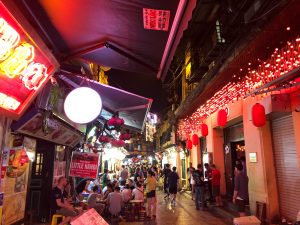 Hanoi is the capitol. The population in Vietnam is 96 million people. 7,5 million lives in Hanoi and around 10 million in Ho Chi Minh City. The official name is the Socialist Republic of Vietnam. The communist party rules everything in Vietnam, although Vietnam nowadays has nothing to do with socialism.
Hanoi is the capitol. The population in Vietnam is 96 million people. 7,5 million lives in Hanoi and around 10 million in Ho Chi Minh City. The official name is the Socialist Republic of Vietnam. The communist party rules everything in Vietnam, although Vietnam nowadays has nothing to do with socialism.
After spending some time in the old quarter, I decided to walk around in Hanoi. Not far from the old quarter, I found the Hoan Kiem Lake. The lake is beautiful, and many Vietnamese come here daily to meet with friends or walk around the lake with their relatives or partner. Young men and women use the lake as a place to exercise. Running and playing badminton is very popular among Vietnamese. Elderly people are having a session of tai chi.
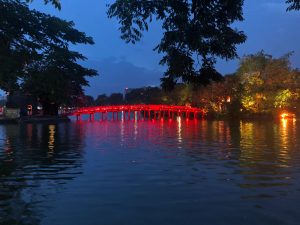 Hoan Kiem Lake, Hanoi. I dagslys og nat
Hoan Kiem Lake, Hanoi. I dagslys og nat
The track around the lake is free from traffic, which is important because it is difficult to find a place in Hanoi, which is quite, and free from the sound of motorbikes. At night, there is a romantic atmosphere. At the north end of the lake there is a small, but incredibly beautiful bridge called the ‘sunshine bridge’, which connects you to Ngoc Son where the Ngoc temple is placed. Meaning temple of the “Jade Mountain” it is Hanoi’s most visited temple. The bridge and the temple are constructed in classical Vietnamese style. The temple is dedicated to general Tran Hung Dao who defeated the Mongols in the 13th century.
The Hoan Kiem Lake is also a great place to meet locals. As I was taking a walk during daytime and at night, I meet so many locals who just approach you, because they want to meet foreigners and get to know them. They simply just want to get to know you, and improve their English. I for example met an English teacher with five students who were looking for a foreigner to start a conversation. I had a great time with them, we spent hours together, where they were practicing English, and I for the time was getting closer to the Vietnamese people. The Vietnamese people are shy, polite, curious and in general very friendly. This is definitely not something you will see in Europe. Something similar also happened on my trip in Cuba. After our talk, we took some pictures together, and they were so grateful for the opportunity to talk with a stranger. I couldn’t stop myself hugging the kids. The Vietnamese people are in general very social and willing to make friendship with foreigners, and the kids are simply lovely.
Next to the Hoan Kiem Lake I also found a monument for the fallen in the war against the French colonialists. Most of these monuments and statues tell us a story about the heroic Vietnamese people and their struggle against colonialism and imperialism. For example, there is a statue of Ly Tu Trong ( 1914-1931) near the west lake. Ly Ty Trong was a Vietnamese revolutionary executed by the French when he was only 17 years old. Ly Ty Trong used a firearm against the French secret police during a rally celebrating the anniversary of the Yen Bai uprising. He did that to protect Phan Boi Chau who was a patriot and revolutionary and threatened by the secret police. Later, the execution of Ly Ty Trong sparked an anger toward the French leadership within communists and nationalists all over Vietnam.
The long bien bridge
I knew I did not have time to see everything in Hanoi. There is too much do and see in the capital. However, I knew I had to see the long bien bridge. It was far away from my hostel in the old quarter, so I had to take a taxi or motorbike to get there. Some locals told me that there is an “app” called Grab, which is a cheap alternative to the taxis (not that the taxis are expensive). It is similar to what we call “Uber”. Anyways I called a “grab motorbike” and the driver picked me up, and dropped me off at the long bien bridge.
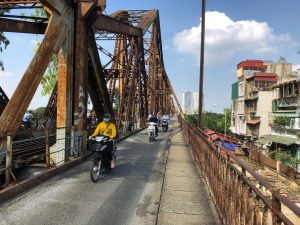 Long bien bridge, Hanoi. Blev bombet under Vietnam krigen, men hver gang repareret af folket
Long bien bridge, Hanoi. Blev bombet under Vietnam krigen, men hver gang repareret af folket
The bridge was built in 1899-1902 and ordered by the French General Governor of Indochina. For the French the bridge was of strategic importance in securing control of northern Vietnam. At 1,68 km in length, it was at that time the longest bridge in Asia. During the aggression war led by U.S. against Vietnam the bridge was heavily bombed in 1967, however the Vietnamese people restored the bridge despite several heavy bombardments. Today the bridge is not in good condition, nevertheless the Vietnamese cross the bridge every day with motorbike. They seem not to care. I think it is worth a visit, because it is a part of the Vietnamese history and symbol of their struggle against their oppressors. From the bridge, there is scenic view over the Red River, and from here you get one of the best views of the traffic in Hanoi, and you start to understand how insane it is.
Hoa lo prison
After a couple of days, I got used to the traffic in Vietnam, and rented a motorbike near my hostel and drove to Hoa Lo Prison, which today is a museum. The prison was built when Vietnam was under French colonization. The Vietnamese called it Hoa Lo, which means “Hell’s hole”. The French called it “Maison Centrale” which means central house. They started building the prison in 1886, and it is located near the French quarter. Here the French held political prisoners who resisted the French colonialism. Thousands of nationalists, revolutionaries and communists were imprisoned and brutally tortured and executed. In the early days of the prison, the capacity was estimated to around 450 prisoners, and later it expanded its capacity to around 600. However, at the end of the French colonialism there were around 2000 prisoners. Several members of the communist Party central committee have spent time in this prison. As in many other prisons where revolutionaries and communists are held together, Hoa Lo prison became a place where revolutionaries were educated in theories of national liberation by Marxist-Leninists.
The museum is worth a visit, because almost everything is translated into English, and the reconstruction of the cells where the prisoners were kept, gives people a terrifying feeling of how inhuman torture is. The French mostly tortured and executed the prisoners in front of the other prisoners. However, Hoa Lo prison was never a successful prison. Many prisoners escaped its walls over the years, and they even managed to dig and squeeze out through sewer grates.
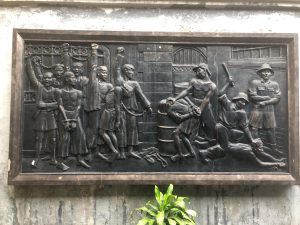 Fransk tortur af kommunister og antikolonialister
Fransk tortur af kommunister og antikolonialister
In the 1960s and 1970s, the prison got a second and more popular name, Hanoi Hilton. The North Vietnamese regime kept American pilots and other crewmembers imprisoned. Those prisoners were American pilots and crew from aircrafts shot down by the North Vietnamese army.
B52 victory museum
On my fifth and last day in Hanoi, I visited the B52 victory museum. People may now ask, why name a museum after a bomber? The answer needs to be found in the Vietnam War during the so-called ‘Christmas bombing’ of Hanoi. In December 1972, the U.S. dropped more than 20.000 tons of bombs over Hanoi. More than 2000 civilians lost their lives. Women, children and hospitals were bombed and destroyed. 12 days of intense of bombardments. The Vietnamese hit 84 of the aircrafts and 34 of these were B52’s. In January 1973, a peace agreement was signed in Paris, the U.S. had to remove all their forces from Vietnam, and that was the end of the U.S. aggression in Vietnam. In 1973, the U.S. national security advisor Henry Kissinger won the Nobel peace prize. I do not even want to comment on that.
This museum is different from any other museum I have seen in Vietnam or anywhere else in the world. The first thing you spot is that there is no ticket office, so there is no entry fee. I did not see any staff or security, and there were almost no visitors. However, what you find in front of this museum are wreckages of the B52 bombers.
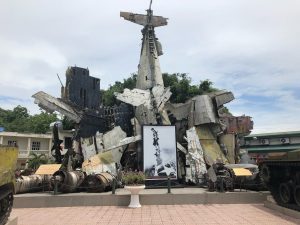 Et amerikansk flyvrag. Flyet er skudt ned over Hanoi af antiluftskyts
Et amerikansk flyvrag. Flyet er skudt ned over Hanoi af antiluftskyts
There also placed some anti-aircraft missiles (from the Soviet Union) and other artillery. Inside there are photos of civilians in Hanoi and the destructions made by the B52 bombers. There are photos of the war criminals, President Nixon and Henry Kissinger. There are also photos of the American pilots. I have to admit, that when I saw the photos of the American authorities and pilots, my brain and thoughts were full of hate and anger. I wanted to spit of their faces, but I stopped myself, when I realized I still was in a museum. I decided to take photos of the American leaders and soldiers with my middle pointing at their face. It is difficult and almost impossible to describe how disgusting they have been in the past. They were not just sick individuals. They represented a sick and disgusting political and economic system.
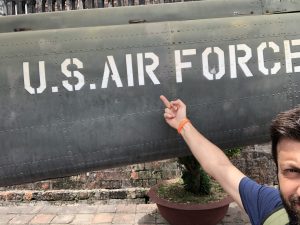 En museumsgæst viser sin begejstring for amerikansk dræberimperialisme
En museumsgæst viser sin begejstring for amerikansk dræberimperialisme
I could not let my emotions get out of control. I had to focus at the museum. On the other wall next to the American authorities there are photos, posters and art showing the heroic Vietnamese people resisting against their enemy. There are photos of the legendary communist General Vo Nguyen Giap, who already during the anti-colonial war against the French in Dien Buen Phu showed what a genius he was.
If you are planning to visit Hanoi, you have to visit the B52 victory museum. Even though the killings and the bombers will not, cheer you up, the resistance the people showed, will motivate and inspire you.
Ho Chi Minh mausoleum
Later that same day I went to the Ho Chi Minh Mausoleum in Hanoi. You cannot travel through Vietnam without seeing or hearing his name. His popularity in Vietnam is enormous.
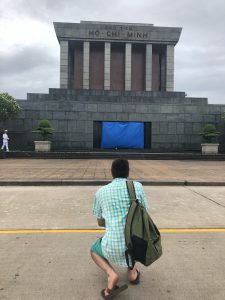 HO Chi Minh mausoleum, Hanoi. Dyb respekt. Sydøstasiens dygtigste marxist-leninist
HO Chi Minh mausoleum, Hanoi. Dyb respekt. Sydøstasiens dygtigste marxist-leninist
Nguyen Sinh Cung, Nguyen Tat Thanh, Nguyen Ai Quoc, Uncle Ho and finally Ho Chi Minh. Who is this man, and why did Ho Chi Minh have so many names? Simply because he had to flew and hide the most of his life. He was born 1890 in Kim Lien in Vietnam into a patriotic family with traditions of fighting against the French colonialists. Ho Chi Minh developed a strong will to expel the colonialists, secure the country’s independence and bring freedom to his people. In 1911, he left his homeland and during 1912-1917, he came to many countries in Asia, America, Africa and Europe where he lived among the working class.
Ho Chi Minh was under influence of the October revolution in 1917. He got in contact with the socialists in France, and he was one of the creators of the French communist party in 1920. Ho Chi Minch was convinced that the road to national liberation was through Lenin’s way and theories. From 1923, he was active in Comintern (communist international, also known as the third International). At the fifth congress of the Comintern, he criticized the French communist Party for their role regarding the national and colonial question. In the French communist party, there were fractions, which were against the liberation of the Vietnamese people from the French colonialism. Chauvinism was a part of the party, however Ho Chi Minh could not accept that as a Marxist-Leninist. He persevered in protecting and creatively developing the ideas of Lenin on national and colonial issues, and struggled intensively to move Comintern in the direction of national liberation. Ho Chi Minh was a political genius, and by the end of the 1920’s he was representing Comintern in Southeast Asia.
In 1924, he went to Guangzhou, China to select a number of young Vietnamese patriots living there to open a political cadres training school. These young people would become the seeds of a new revolutionary, pro-communist movement in Vietnam several years later. When Chiang Kai-Shek, the commander of the Chinese army, expelled the Chinese communist in 1927, Ho Chi Minh had to go back to Moscow. The same year he went to Berlin and Brussels again representing Asia in an anti-imperialist conference. From 1928, he operated in the movement mobilizing overseas Vietnamese revolutionaries in Thailand, and continued to prepare the establishment of the communist party of Vietnam. In 1930, the communist party of Vietnam was founded (later renamed Indochinese communist party, PCI). In that period repression by the French was brutal. Ho chi Minh was condemned in absentia to death. In 1931, he was arrested by the British imperialists in Hong Kong, and was set free in 1933. From 1934 to 1938, he studied at the institute of research on national and colonial problems in Moscow.
In 1938, he went to China, and met with the Chinese communists and stayed with Mao Zeodong. In 1941, Ho chi Minh finally returned to Vietnam after 30 years of revolutionary activities abroad. He, Vo Nguyen Giap, Pham Van Dong and their comrades established the ‘Viet Minh’ (Vietnam independence league).
In the Second World War Japan completely overran French Indochina. This gave Ho Chi Minh and the anti-colonial movement a historic opportunity to gain power. In the beginning of august 1945 the U.S. dropped atomic bombs on Japan, and Japan was totally defeated. At that time, the French were not able to defeat the Viet Minh, and the August revolution began. The 2.th of September 1945, Ho Chi Minh read the declaration of Independence, and proclaimed the birth if Democratic Republic of Vietnam.
Soon after that, the French colonialist provoked a war to start a second period of colonization. In 1946, the French started the war, but the Vietnamese organization was too strong. The Vietnamese people were tired of slavery. They wanted national liberation and social justice. Therefore, the French led a crushing defeat at Dien Bien Phu in 1954, and they had to give up their interests in Vietnam. Before the war against the French, Ho Chi Minh said: “We would rather sacrifice everything than lose our independence and be enslaved”. They certainly did.
However, the imperialists wanted something else, and Ho Chi Minh had to accept that Vietnam was going to be divided into North Vietnam and South Vietnam. At the Geneva conference in 1954 it was decided that Vietnam would divided until 1956, and democratic elections would be held under international supervision. The communists in the North struggled for socialist construction in the North and peaceful reunification of the country, as uncle Ho said. The election never became reality. Everyone knew that Ho Chi Minh and the communists would win. The US supported the fascist regime in South Vietnam, and when communist forces started to grow in the south they began their aggression war against Vietnam.
All these thoughts went through my mind when I was standing at the Ba Dinh Square in Hanoi. Ho Chi Minh, what a great leader! ‘Uncle Ho’, you are a genius. Such a big heart, dedicated for national liberation, internationalism and socialism. I have spoken to lots of Vietnamese people on my trip through the country. Everyone loves Ho Chi Minh. His importance cannot be neglected by anyone. Even though the Vietnamese consider the Communist party in Vietnam nowadays as corrupt, history will remember him, and he is a source of inspiration for people all over the world.
For the first time in my life, I went on my knees to show my deepest feelings and respect to Ho Chi Minh and the Vietnamese people who fought bravely against colonialism and imperialism.
HA LONG BAY AND NORTH VIETNAM
After almost a week in Hanoi I needed a break from the big city. I had to explore the landscape of Vietnam away from traffic and all the pollution. Most people who intend to visit Vietnam have at least heard of Ha Long Bay, and it was definitely on my ‘bucket list’. Ha Long Bay is located in northeast of Vietnam, is listed as a UNESCO’s world heritage site, and is one of the main tourist attractions.
First I tried to visit Ha Long bay on my own, but found that it is not as easy as it seem. I mean you can visit the bay on your own, by renting a car and buy a tour when you arrive at the bay. But the problem is, that are so many companies out there, and they will overcharge you if you haven’t booked in advance. Another thing is the security problem. The level of corruption in Vietnam is not like in New Zealand or Denmark. According to transparency international Vietnam is ranked 107 out 180 countries in the world. This clearly has an influence on Ha Long Bay where several companies who doesn’t follow the security regulations operate in the bay, and transport thousands of tourists every year. In 2011, 11 tourists and their tour guide drowned in the bay, and several people where rescued. This is just one simple example out of many when it comes to safety regulations in Vietnam.
Therefore I made an exception and booked a 4-star tour in Hanoi with an all-inclusive boat. They picked me up in the morning, and 4 hours later we arrived at the bay. There are moments in life where the beauty of a landscape is breathtaking. New Zealand is a country full of breathtaking landscapes and moments, and so is Ha Long Bay. It is incredibly beautiful. The bay has an area of 1500 square km and consists of almost 2000 islets, most of which are limestone. Several of the islands are hollow with huge caves. What you will do in Ha Long Bay is not complicated. You sit on the top of a luxury boat, and enjoy the bay. One of the best things is when you are kayaking in between the islets in a group, and while you are surrounded by this beautiful view, your only thought is, that you don’t want this moment to have an end. I stayed one night on the boat. Depending on peoples budget there are many options, but no matter what you choose, it is worth all the money.
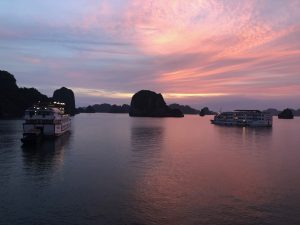
After an unforgettable night in Ha Long Bay I went on a bus, and my next destination was the mountains in the north. After 6 hours in a bus I arrived in Sa Pa town. Sa Pa is a beautiful and peaceful town in the north of Vietnam close to the Chinese border. This town is completely different from Hanoi. There is less traffic, it is more authentic and the locals are friendlier when they approach foreigners. In this region you will find beautiful national parks, lakes, rivers and rice fields. Rice fields are one of the most photographed views in Vietnam. Mount Fansipan (highest in Vietnam) is also close and can be seen from Sa Pa town.
I booked a guided tour in the mountains which includes trekking, visiting the villages in the mountains and plenty of opportunities to get close to the locals. I visited several villagers in this region. They are poor, but not starving. They have a small farm, a local business and produce different kind of products, which they want to sell to the tourists. The quality is actually really good. A sad thing I saw in the Sa Pa region was the amount of kids working in the town or in the villages. I saw hundreds of kids working from early morning until evening.
Tourism is relatively new in Vietnam (last 25 years), however it is one of the growing sectors –especially in North Vietnam. Hotels, tour companies and locals – all of them want a piece of the cake. The locals whom I visited in Vietnam were all living in the North. All the homes I visited had a photo of Ho Chi Minh in the living room. As a villager in the Lao Cai province told me when I saw his Ho Chi Minh photo next to the TV: “everybody loves Ho Chi Minh, but nobody loves the communist party”. I asked him why it is like that, and he answered: “because after Ho Chi Minh died, and when the Vietnam war ended, they started acting like a mafia and not like communists”. Most people I met all over Vietnam were saying almost the same.
HUE AND HOI AN
After spending almost 5 days in Ha Long Bay and North Vietnam, my next destination was the central east coast. I booked a flight, because otherwise I had to sit in a bus for 18 hours, and I was also in a hurry.
It took me an hour to get to Da Nang, which is a big city, however I didn’t stay long. From the airport I got on a bus, and we drove to the Hue, imperial City. Hue is one of my favorite places in Vietnam. Everything is more organized, the streets are cleaner and in the old the quarter most of the time motorbikes and cars cannot enter. Here you can walk around, enjoy the atmosphere and have a look at the small shops with all kind of handmade stuff.
However, Hue is mostly known for the Imperial City, being one of Vietnams seven UNESCO heritage sites. In 1802 Nguyen Anh (Emperor Gia Long) established his control over Vietnam, when they defeated the Thay Son dynasty. The Nguyen dynasty lasted until 1945, where Ho Chi Minh and the communists gained power in the north. During the colonization the French controlled Vietnam through the Emperor.
As a result, the imperial city is impressive, is surrounded by huge walls, and inside you can find impressive monuments, palaces and temples.
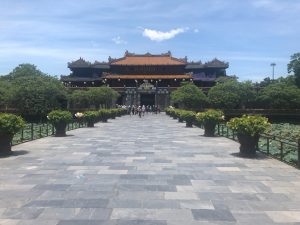
Because of the location of Hue, it was also damaged during the French re-colonization of Vietnam (1946-1954), but especially damaged during the American aggression war against the Democratic Republic of Vietnam and the Vietnamese people. However, Imperial City is definitely worth a visit to understand the modern history of Vietnam.
I was still in a hurry, and therefore I could not spend more than 2 nights in Hue even though there is much to do and see. I guess 3 nights would be perfect, but I had to move on, and my next destination was not far from Hue. I booked a seat on a shuttle bus, and two hours later I arrived in Hoi An.
I previously said that Hue is one of my favorite spots in Vietnam, however Hoi An is my favorite. I do have to mention that it is a UNESCO world heritage site. Most of the world heritage sites in Vietnam are declared in the 1990s, because Vietnam opened for capitalist market economy in mid 1980s. However here you will find a magical city, almost all houses are in yellow and the Thu Bon River splits the city in beautiful pieces. Hoi An is the most touristy city in Vietnam, however it remains its charm and beauty despite it is crowded. Here you can explore the Vietnamese kitchen, taking a cooking class, however you will pay much more than the in the north of the country. The quality of food in Hoi An is really good. The street kitchens are much cleaner compared to the other parts of Vietnam, and the restaurants make really good Vietnamese and European food.
Cars and motorbikes are banned from the center of Hoi An (not everyone follow the rules), and the best way to explore the center is by walking – especially around the ‘Japanese bridge’. Grab a bicycle and explore around Hoi An, and there is a beautiful beach near the city. Vietnamese love to spend the whole day at the beach where they often make barbecue.
Kayaking or a boat tour in the river is one of the best things you can do in Vietnam –especially at night.
Most tourist come to Hoi An, because they want to feel the authentic Vietnam, relax and have a good time. Those who want to explore the history and politics of Vietnam are heading for Ho Chi Minh City, which was my next and final destination.
HO CHI MINH CITY
I booked my last domestic flight in Vietnam and flew from Da Nang to Ho Chi Minh City (HCMC), which is the largest city in Vietnam. It was the capital of South Vietnam under the name Saigon until the reunion of North and South Vietnam, where it was renamed Ho Chi Minh City.
I was located at the backpacker quarter of the city, which is a noisy area, however a fun place to stay if you travel on your own and want to meet new people. The traffic is even worse than in Hanoi. The motorbikes are everywhere, however I was used to the traffic at that time, and I wasn’t stressing at all anymore. It is not easy to get around in HCMC, because the infrastructure is in terrible condition, so taxis will be the easiest way to get around. However there is much to do and see.
I started at the Opera House. It is also a theater and I even watched a play there. I didn’t understand much, but the building itself is an impressive example of French colonial architecture, and it was interesting to watch a play in a country with a different style and culture. Again if you are into beautiful architecture Saigon Notre Dame is worth a visit, and not to forget the central post office, which is designed by the famous Gustave Eiffel.
There are plenty of interesting markets in HCMC. One famous is Ben Thanh market, and here you can buy lots of interesting stuff much cheaper than in Europe. But, be aware they will try to overcharge you. To keep it simple, if they mention a price at a market, the real price you will have to pay is often only 25% of the price they gave you at the beginning.
There are two things I regret regarding my stay in HCMC. I missed the Cu Chi tunnels North West from the city. The Cu Chi tunnels were built by the communists during the Vietnam war. Many soldiers and communist leaders were living in these tunnels for months, however the U.S. and South Vietnamese regime were unable to destroy the tunnels. I also missed the Independence Palace. The independence palace was the work place for the South Vietnamese president until 1975. It was the site of the end of the Vietnam War in april 1975 when a North Vietnamese tank crashed through its gates. After the war it was renamed as the reunification palace.
War Remnants Museum
I only had 2 days in HCMC, and knew I could not miss the war remnants museum. On my last day in Vietnam I spent almost half the day at the museum. This museum is probably the best museum I visited in Vietnam. Unfortunately the best museum is about war crimes committed by the French colonialists, American imperialists and the South Vietnamese regime.
Outside the museum they have placed tanks, choppers and artillery used during the war. Most of the aircrafts and artillery belonged to the U.S, which were caught by the communist guerrilla. Inside the museum in the ground floor, you will find photos of protesters during the Vietnam War. There are hundreds of photos showing us, that the Vietnamese people were not alone. Thousands of people on every continent were weekly demonstrating, struggling and fighting with police and their government to bring an end to this criminal war. It is a great feeling, knowing that thousands of people around the world support you and fight for you.
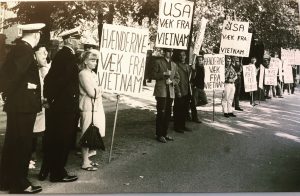 Unfortunately this great feeling would disappear immediately as I walked up to the first floor of the museum. This floor showed us the real horror of the war and the real face of the U.S. administration, and how disgusting the imperialists can be. Here I saw the tortured villagers and communists – mainly by the French. Images were showing us how the U.S. bombed and destroyed villages and villagers. They used all kind of the bombs in Vietnam. The American authorities planned to bomb Vietnam back to the Stone Age, and they almost did. Millions of civilians were helping the Viet Minh guerrillas with supplies. They were transporting food and ammunition with bicycles to the jungle, and to cut this supply line, the U.S. systematically bombed civilians.
Unfortunately this great feeling would disappear immediately as I walked up to the first floor of the museum. This floor showed us the real horror of the war and the real face of the U.S. administration, and how disgusting the imperialists can be. Here I saw the tortured villagers and communists – mainly by the French. Images were showing us how the U.S. bombed and destroyed villages and villagers. They used all kind of the bombs in Vietnam. The American authorities planned to bomb Vietnam back to the Stone Age, and they almost did. Millions of civilians were helping the Viet Minh guerrillas with supplies. They were transporting food and ammunition with bicycles to the jungle, and to cut this supply line, the U.S. systematically bombed civilians.
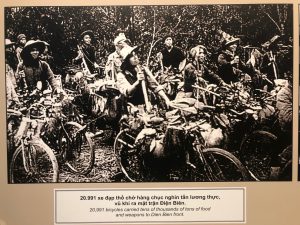 I will never forget the terrified faces of old and young women protecting their family and village, when the American war criminals were murdering their husbands, brothers, fathers and sons in front of their kids. On this floor you will also find photos of American soldiers posing proudly in front of a camera showing a communist guerilla they have killed. I have to admit, it wasn’t easy to walk around and watch this.
I will never forget the terrified faces of old and young women protecting their family and village, when the American war criminals were murdering their husbands, brothers, fathers and sons in front of their kids. On this floor you will also find photos of American soldiers posing proudly in front of a camera showing a communist guerilla they have killed. I have to admit, it wasn’t easy to walk around and watch this.
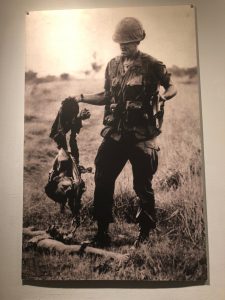 The U.S. government started their activities in Vietnam with President John F.Kennedy. All American presidents in the 20th century were anti-communists, and they would do anything it takes to prevent a worldwide communist growing, independence or social justice. And they certainly did. They dropped more bombs in Vietnam, than there were used during the whole Second World War. The used all kind of illegal chemical weapons during the war and committed war crimes, and are responsible for one of the most aggressive genocides in the 20th century. The U.S. had more than half a million troops in Vietnam at the peak, they dropped 14.300.000 tons of bombs over the civilians, guerillas, hospitals, schools, rice fields, bridges and jungle. The U.S. spent 676.000.000.000 US dollars on this war and had 58.000 casualties and 300.000 wounded. The U.S. and their allies killed 3.000.000 Vietnamese and among them 2.000.000 civilians. Seeing the war photos made me sick, however knowing these facts about the war make me want to throw up. Countries supporting the U.S. either with troops, financially or with military equipment were: Canada, South Korea, Australia, New Zealand, Taiwan, Thailand and Phillippines.
The U.S. government started their activities in Vietnam with President John F.Kennedy. All American presidents in the 20th century were anti-communists, and they would do anything it takes to prevent a worldwide communist growing, independence or social justice. And they certainly did. They dropped more bombs in Vietnam, than there were used during the whole Second World War. The used all kind of illegal chemical weapons during the war and committed war crimes, and are responsible for one of the most aggressive genocides in the 20th century. The U.S. had more than half a million troops in Vietnam at the peak, they dropped 14.300.000 tons of bombs over the civilians, guerillas, hospitals, schools, rice fields, bridges and jungle. The U.S. spent 676.000.000.000 US dollars on this war and had 58.000 casualties and 300.000 wounded. The U.S. and their allies killed 3.000.000 Vietnamese and among them 2.000.000 civilians. Seeing the war photos made me sick, however knowing these facts about the war make me want to throw up. Countries supporting the U.S. either with troops, financially or with military equipment were: Canada, South Korea, Australia, New Zealand, Taiwan, Thailand and Phillippines.
If the first floor hasn’t knocked you out, the second floor definitely will. The rooms on the second floor are called “Agent Orange”, which was the most toxic chemical the U.S. used against the Vietnamese people to prevent the advance of the revolutionary armed forces. From 1961 to 1971, the U.S. army conducted almost 20.000 missions, spraying about 80 million liters of toxic chemicals (61% Agent Orange) over nearly 26.000 villages, with an area of 3 million hectares. This was almost the quarter of the total area of South Vietnam. 4.8 million Vietnamese people were exposed to Agent Orange.
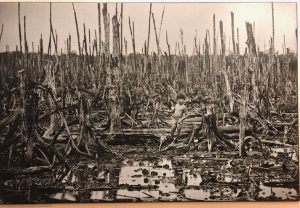 The photos of the victims are terrifying. The chemicals caused thousands of deaths, thousands of people with mental retardation, blindness, cancer, paralysis and physical abnormalities. Some of the victims were actually working at the museum.
The photos of the victims are terrifying. The chemicals caused thousands of deaths, thousands of people with mental retardation, blindness, cancer, paralysis and physical abnormalities. Some of the victims were actually working at the museum.
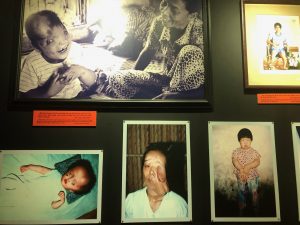 On the second floor there were also some few photos of American veterans, living a miserable life back in the US. Some of them had to take around 20 pills every day because they were suffering from depression, anxiety, posttraumatic stress and suicidal thoughts. Most of the American soldiers were taking drugs during the war. I guess you have to take drugs to commit the crimes they did. Next to them there were photos of Americans refusing to go to Vietnam for war, and showing them burning their cards and willing to go to prison instead of killing innocent people.
On the second floor there were also some few photos of American veterans, living a miserable life back in the US. Some of them had to take around 20 pills every day because they were suffering from depression, anxiety, posttraumatic stress and suicidal thoughts. Most of the American soldiers were taking drugs during the war. I guess you have to take drugs to commit the crimes they did. Next to them there were photos of Americans refusing to go to Vietnam for war, and showing them burning their cards and willing to go to prison instead of killing innocent people.
The last thing I want to share with you, is that I highly recommend everyone to visit this museum, because wars and crimes made by imperialism are not over. The lies they told in the past, during and after the Vietnam War, are the same lies we hear nowadays. They lied about weapons of mass destructions in Iraq, and they are lying when they are talking about North Korea or the Syrian Government. If we don’t study or learn, history will repeat it self as it does nowadays.
Everything has an end, and my trip in Vietnam had come to an end. This trip was different from most of my previous trips. The Vietnamese people are as I have mentioned before curious by nature, and therefore it was easy for me to meet locals, and get to know their life and culture. I was deeply moved by their friendly smile and the innocent look in their eyes. They don’t earn much, but most of them are generous. They work really hard and most of them are poor. Vietnam has an incredible beautiful nature. I have seen some of the most beautiful places on earth. But most of the Vietnamese don’t even have the opportunity to explore their own country. I have seen hundreds of construction workers, working for 5 star hotels under slavery conditions. There are thousands of kids working in the streets. All over Vietnam there are thousands of young men and woman working for foreign companies for an extremely low salary.
Vietnam has a bloody but also a heroic history. They have showed us how they could resist against colonization, and free their country from slavery. They could even resist a second colonization by the French, and against all odds win against the American war criminals. Vietnam is one of the examples of brilliant leadership and strong organization, which at the end is more powerful than tons of bombs and chemical toxins. After the Vietnam War 100 percent of the power plants, most bridges, 66 of 70 state farms, 28 towns, 350 hospitals, 2900 schools and tens of thousands of hectares land were destroyed. Therefore the system had serious problems when they were trying to build socialism, and not to forget that they lost the most dedicated and organized part of the population. Unfortunately the regime has nothing to do with socialism nowadays, and there are signs of U.S. presence everywhere.
Although socialism was not successfully built in Vietnam, I owe Ho Chi Minh, his comrades and the Vietnamese people my deepest respect and feelings for showing us the right way. The imperialists have done enormous harm in Vietnam, however Vietnam and its people have taught us priceless things, and I consider them as one of the most heroic people of the 20th century. They are a source of inspiration.
At the beginning of July 2018 an airplane belonging to Qatar airways departed from Ho Chi Minh City, and I was on my way home, however I wasn’t happy. I wanted to stay with the Vietnamese…
Thank you for reading my Vietnam.
 Dette er en artikel fra KPnet.
Dette er en artikel fra KPnet.
Se flere artikler og følg med på
KPNET.DK – NYHEDER HVOR DER KÆMPES
– eller på FACEBOOK
Udgiver APK Arbejderpartiet Kommunisterne – FACEBOOK
KPnet 3. august 2018
Dette er en artikel fra KPnet. Se flere artikler og følg med på
KPNET.DK – NYHEDER HVOR DER KÆMPES – eller på FACEBOOK
Udgives af APK – Arbejderpartiet Kommunisterne

